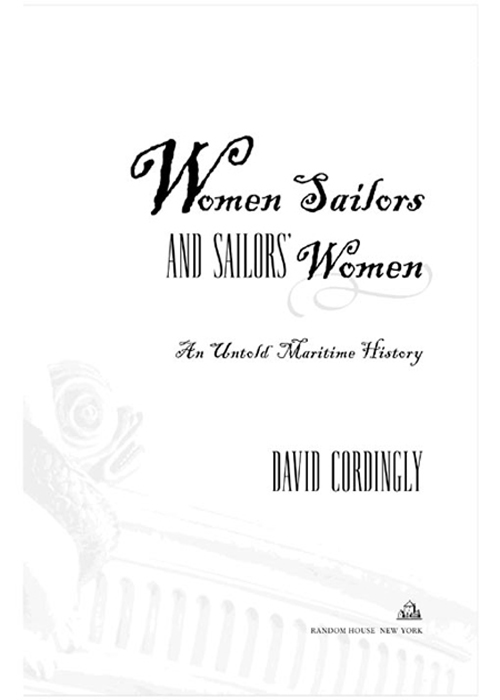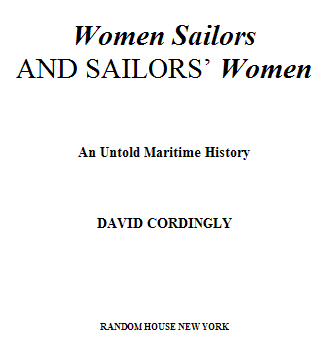Women Sailors & Sailors' Women




For Shirley
CONTENTS
Â
3
 Ann Parker and the Mutiny at the Nore
Â
4
 Female Sailors: Fact and Fiction
Â
5
 Hannah Snell, Mary Anne Talbot, and the Female Pirates
10
 Women and Water, Sirens and Mermaids
INTRODUCTION
From earliest times the sea has been regarded as a male domain. Fishermen labored around the coasts with nets and lines while their wives stayed on shore to mind their homes and bring up their children. Later explorers and adventurers set sail across the oceans in search of new lands hoping to make their names and their fortunes from their discoveries. The crews of their ships, as well as the crews of the hundreds of thousands of merchant ships and warships that would follow in their wake, were always male. Or were they?
Recent studies have shown that a surprising number of women went to sea. Some traveled as the wives or mistresses of captains. A few were smuggled aboard by officers or by seamen of the lower deck. An increasing number of cases have come to light of young women dressing in men's clothes and working alongside the sailors for months and sometimes years on end. In 1807, Lieutenant William Berry of HMS
Hazard
was charged with committing “the unnatural and detestable sin of sodomy” with a boy in the crew.
1
One of the principal witnesses at the court-martial was a fourteen-year-old girl from Cornwall named Elizabeth Bowden. She was listed on the books of the
Hazard
as a boy of the third class and appeared in court dressed in a long jacket and blue trousers. It had taken her shipmates six weeks to discover her sex, and when they did so, the captain of the
Hazard
gave her a separate apartment to sleep in and allowed her to remain on board as an attendant to the officers. Hannah Snell, the most famous of the female sailors, spent four and a half years serving in the army and the navy as a man in the 1740s and astonished her companions when she finally decided to reveal that she was a woman.
It is equally surprising to find that it was common practice in the British Navy and not unusual in the United States Navy for the wives of boatswains, carpenters, and cooks to go to sea on warships. They acted as mothers to the boys in the crew, and when the ship went into action, they assisted the gun crews and nursed the wounded. Exactly how many ships had warrant officers' wives on board we shall never know, because their presence was not officially acknowledged, but every now and again we learn of their presence in an old seaman's memoirs or in the transcripts of a court-martial. The journals of ships' surgeons are a particularly valuable source of information because they note whether a woman on board has given birth to a baby beside the guns, or whether visiting prostitutes have caused an outbreak of venereal disease among the crew. Captain John Fyffe, commander of HMS
Indefatigable,
took the unusual step of including women in the set of orders that he drew up for his crew in 1812: “The women belonging to the ship are to be permitted to go on shore twice a week on market days. Should they go on any other day, or in any respect act contrary to the regulations of the ship, they are not to be suffered to come on board again.”
2
In the nineteenth century, a number of the captains of merchant ships took their wives to sea with them, and in several cases the wives had to take charge of the ship when the captain fell ill. Some of these women proved to be truly heroic. Mary Patten was nineteen years old and four months pregnant when her husband collapsed in a storm as they approached Cape Horn. Since no other member of the crew could navigate, she took command of the vessel, a clipper ship the size of the
Cutty Sark,
and sailed her around the Horn to San Francisco. Equally heroic were the women who looked after the lighthouses. The most famous was probably Grace Darling, who in 1838 helped her father row an open boat through a winter gale to rescue the survivors of a shipwrecked paddle steamer from a rocky outcrop off the coast of Northumberland. She became a national heroine, but her exploits pale into insignificance beside the achievements of the American lighthouse keeper Ida Lewis, who for thirty years looked after Lime Rock light in the harbor of Newport, Rhode Island. During that time she rescued eighteen lives, on several occasions risking death to do so. The U.S. Life Saving Service presented her with its highest award for her “unquestionable nerve, presence of mind, and dashing courage.”
3
This book began as a study of seafaring heroines like Mary Patten and Hannah Snell, but it soon became apparent that there was scope for a wider study. The women's lives were defined by their role in a traditionally male world, so it seemed logical to question the role of the men in that world. What did the sailors think of their women? Did they simply love them and leave them and forget all about them when their ship sailed over the horizon? To what extent did sailors live up to their reputation for having a wife in every port? How does one reconcile the sailor's love of women with the superstition that a woman at sea brings bad luck? And what about all those sailors' stories about mermaids?
This proved to be a vast subject and some of the findings have been unexpected. The usual view of the seafaring man is that once he heads out to sea, he is far too busy to concern himself with women. Mariners' journals are mostly filled with observations on the weather, navigational notes, and the behavior of the ship and the crew. If the mariner is of an inquiring mind, he records unusual birds and sea creatures and the appearance of islands and harbors overseas. We imagine that when he has any spare time at sea, the sailor spends it mending sails, tying knots, making ship models, gambling, drinking, smoking, dancing the hornpipe, or singing sea chanties. In fact, sailors spent, and no doubt still do spend, a great deal of time thinking about women. Many, if not most, of their songs and sea chanties featured women; they decorated their arms and chests with tattoos dedicated to their mothers or sweethearts; they collected souvenirs to take home to their women; and above all they wrote letters to their women. These letters are often heartrending to read and show that the happy-go-lucky sailor was often desperately homesick and wanted nothing more than for the voyage to end so that he could return to his loved ones at home.
There were of course many who reveled in the freedom and opportunities that a sailor's life gave them. Captain Augustus Hervey took full advantage of his aristocratic connections, and his dashing image as the commander of a 74-gun warship, to bed every attractive woman he met during his voyages around the Mediterranean. Most of the young, unmarried sailors in the navy and the merchant service lost no time in seeking out women in the brothels and dance halls of the waterfront whenever they were given permission to go ashore in a foreign port. There is nothing surprising in this, but it is interesting to learn from the evidence of prostitutes and policemen operating in the sailors' district of London in the nineteenth century that sailors frequently sought out the same prostitutes each time they came ashore, entrusted them with their wages, and in general treated them as if they were married to them for as long as they remained in port.
And what about the women who were left behind? It has to be said that the lot of a sailor's woman was not a happy one. “I wish you had been a parson or anything but a sailor,” wrote Jenny, wife of Captain George Rodney, in 1756. “Then I had not known the uneasiness of being parted from him I love better than life.”
4
For some it was the loneliness that was the worst thing. For others it was the prolonged separation and the constant, gnawing anxiety that their husband and the father of their children might be lost at sea. This applied to the wife of an admiral as well as to the wife of an ordinary seaman, or a Scottish fisherman, or a deckhand on a whaling ship. And all too often there were tragedies that left a widow and orphans grieving their loss.
With a few exceptions the scope of the book has been limited to the seafarers and their women on both sides of the North Atlantic and in particular to those based on the principal ports of Britain and the United States. Occasional forays into the Pacific have been limited to the voyages of the American whaling ships and a brief glimpse at the lovely women of Tahiti, who became a legendary attraction for sailors following the visits of Captain Cook and Captain Bligh to an island that was seen as an earthly paradise.
The subject matter has been set out in the form of a voyage, beginning with the ships at anchor and looking at the life of sailors' women in the seaports. We move on to observe the press gangs rounding up men to fill the ships before they set sail, and then follow the ships to sea. Out at sea we find that among the apparently all-male crew are a number of women disguised as cabin boys or marines, and we find out which of the stories of female sailors are true and which are fictitious. We also follow the lives of the wives of warrant officers and captains of merchantmen and whaling ships who accompanied their husbands on their voyages. The chapter on men without women begins with a look at homosexuality on board naval ships as revealed in some of the courts-martial of the eighteenth century. The transcripts of these trials are extraordinarily graphic in their description of what took place and reveal the draconian punishments that the Royal Navy inflicted on those found guilty of the crime punishable by the 29th Article of War.
The ambivalent attitude of sailors toward women at sea is examined in the chapter on women and water. The old adage that women brought bad luck is entirely contradicted by the centuries-old belief that women had mystical powers over the oceans. In the era before Christ, sailors in distress would appeal to an appropriate goddess, and in Christian times, they prayed to the Virgin Mary for a safe voyage and deliverance from the perils of the sea. On the other hand, we find the conventional belief that most ships' figureheads depicted women to be far from the case. The predominance of female figureheads was a nineteenth-century phenomenon, and it is only because so many more of these have survived than the earlier lions, dragons, and warriors that we assume that women were more popular on the bows of ships.
From figureheads, sirens, and mermaids, we move on to the behavior of sailors in foreign ports, and then as the ships return home, we look at the lighthouses that guarded the coast and the stories of some of the women who looked after the lights. We end with the sailors' return and see how the women fared in their absence. We are back in the seaport where the voyage began.